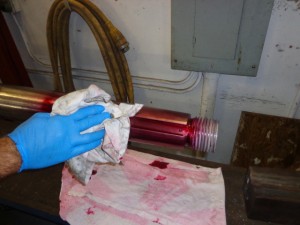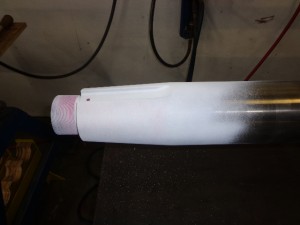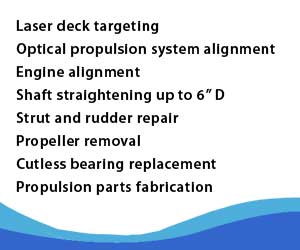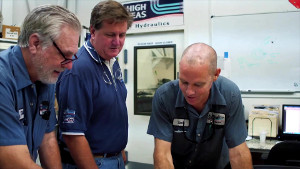Crack Testing
Any vessel that is in “Class” (Llyods, ABS…) requires a five year shaft survey. That survey includes crack testing of the shafts and propellers in a machine shop. However, not everyone who does crack testing should be doing crack testing. Proper testing requires a highly skilled and trained technician. This is why Lloyds requires Level II certification for machinists to perform crack tests on Llyods class vessels. Level II technicians have been trained on the proper procedures and how to interpret the results. There are very few machine shops in the marine industry who have earned this difficult certification for shaft work.
 I am often asked, “What makes testing so specialized and difficult? Doesn’t the technician merely clean the shaft and then coat it with a dye followed by a developer?” Actually, crack testing uses a dye penetrant process that allows hairline cracks to be seen by the human eye. A specialized red dye is sprayed onto a cleaned area of the shaft – usually the prop and coupler tapers. Once dried, the surface dye is removed by a specialized solvent. If there is a crack, small amounts of the dye will remain down inside the crack. The next step involves spraying a developer in the same area. The developer quickly dries to a white powder and wicks the red dye out of the crack. A crack will show up as red dye in the white powder. Although the process sounds simple enough, the dye appearing in the powder can have varying meanings. This is where the training, experience, and certification come into play. The technician must be able to correctly “interpret the results” of dye testing. In NDT (nondestructive testing) the dye test may indicate what appears to be a crack; however in reality, it is only an imperfection and not a crack.
I am often asked, “What makes testing so specialized and difficult? Doesn’t the technician merely clean the shaft and then coat it with a dye followed by a developer?” Actually, crack testing uses a dye penetrant process that allows hairline cracks to be seen by the human eye. A specialized red dye is sprayed onto a cleaned area of the shaft – usually the prop and coupler tapers. Once dried, the surface dye is removed by a specialized solvent. If there is a crack, small amounts of the dye will remain down inside the crack. The next step involves spraying a developer in the same area. The developer quickly dries to a white powder and wicks the red dye out of the crack. A crack will show up as red dye in the white powder. Although the process sounds simple enough, the dye appearing in the powder can have varying meanings. This is where the training, experience, and certification come into play. The technician must be able to correctly “interpret the results” of dye testing. In NDT (nondestructive testing) the dye test may indicate what appears to be a crack; however in reality, it is only an imperfection and not a crack.
 As cracked shafts are not repairable, a misdiagnosis would result in discarding a perfectly good shaft. Unfortunately, sometimes the opposite is true. What a technician thinks is only a surface imperfection is actually a serious structural flaw. Once again, the improper diagnosis would result in an otherwise avoidable expense. It requires incredible skill, knowledge, and experience to “call it” correctly. As such, the best means to save money and protect against unnecessary expense is to select a certified, full-service shop. Most captains and engineers agree that the selection of a facility that meets Llyods and ABS certification requirements is a no-brainer.
As cracked shafts are not repairable, a misdiagnosis would result in discarding a perfectly good shaft. Unfortunately, sometimes the opposite is true. What a technician thinks is only a surface imperfection is actually a serious structural flaw. Once again, the improper diagnosis would result in an otherwise avoidable expense. It requires incredible skill, knowledge, and experience to “call it” correctly. As such, the best means to save money and protect against unnecessary expense is to select a certified, full-service shop. Most captains and engineers agree that the selection of a facility that meets Llyods and ABS certification requirements is a no-brainer.
The typical questions I get when a crack is detected are:
How bad is the crack…How deep is it…How long will my shaft last?” Regardless of who asks the question, my answer is always the same, “It depends upon how much you are willing to gamble.”(I think most people agree that Murphy always shows up at the worst possible time). If you are in the middle of the Gulf Stream and your shaft breaks, at a minimum you can say goodbye to your propeller (and if you are really lucky, the prop won’t punch a hole in the bottom as it spins uncontrolled off the shaft). So, besides losing a screw worth many thousands of dollars (now a permanent fixture on the ocean floor), you’re also probably in the middle of nowhere. The final answer is – a cracked shaft must be replaced.
The next time you are up for a shaft survey, select a company that has all the right qualifications in-house. High Seas Yacht Service will do all of the mechanical work, alignment work and shaft machine shop work, including in-house, Level II crack testing.


 Click to watch the video of a day at High Seas Yacht Service.
Click to watch the video of a day at High Seas Yacht Service. Click to watch Marine Industries Association of South Florida video featuring Salty Jobs at High Seas Services.
Click to watch Marine Industries Association of South Florida video featuring Salty Jobs at High Seas Services.